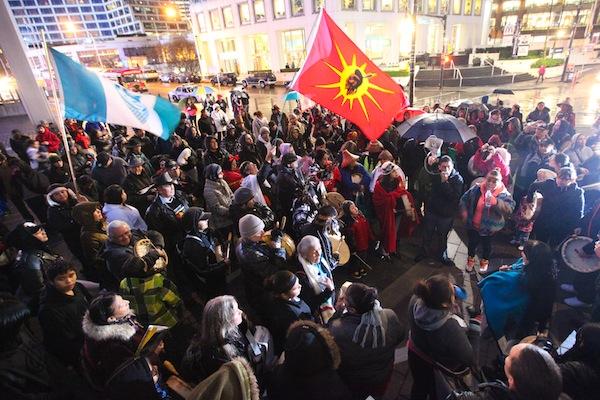Idle No More Enters a New Phase, Seeks Next Steps

Idle No More’s founders and leaders are determined to keep the movement’s momentum going and to maintain pressure on aboriginal leaders and the federal government to enact concrete change.
As Parliament resumed on January 28, activists in at least 30 cities held a second Idle No More day of action, continuing to set themselves apart from official leadership and the six-week-long, liquids-only fast of Attawapiskat First Nation Chief Theresa Spence, which ended on January 24.
“Our nationhood can’t just be words in a constitution,” said lawyer Pamela Palmater, Mi’kmaq, chair of the Centre for Indigenous Governance at Ryerson University in Toronto and runner-up in last year’s Assembly of First Nations (AFN) national chief race. She told Indian Country Today Media Network, “It has to be recognized and implemented and respected—and that’s what this movement is about: shifting everything.”
Idle No More wants to keep aboriginal issues on the radar of mainstream Canadians and in the national dialogue while going beyond the flash mobs and rallies with which the movement has become virtually synonymous.
“We have seen the demands emanating from the grassroots sharpening and becoming even more precise,” Glen Coulthard, assistant professor of First Nations Studies and Political Science at the University of British Columbia (UBC), told ICTMN. “Before, it used to be housing conditions, the material conditions on reserves, and the attack on some of the environmental and land concerns with omnibus Bill C-45. Now we’re focusing on the core issue: setting right the relationship between indigenous and non-Indigenous Peoples in Canada.”
Sylvia McAdam, Cree, one of the four female founders of Idle No More, wants to continue broadening its support. “I keep telling as many people [as I can] that it’s not an indigenous movement, because Bill C-45 affects all of us,” the Big River First Nation member said. “I believe that the voice of Idle No More—the voice of grassroots people—will become clearer and more focused.”
Some fear the movement could lose energy following the January 11 meeting that Atleo and other AFN chiefs had with Prime Minister Stephen Harper. Others see the 13-point Declaration of Commitment signed by the chiefs, including Spence, on January 24 as an attempt by aboriginal leadership to co-opt the grassroots movement. There are even whispers about a possible coup inside the AFN by those who felt the Harper meeting was a capitulation of sorts.
“There’s going to be political fallout,” Palmater said.
“Where progress will be made is in the reunification of
leadership with the grassroots people. The kind of core,
fundamental breakthrough that we’ve been looking for is that
the chiefs would listen to the people and stand by their
people.”
But some are wary. McAdam insisted that Idle No More is
independent from leadership, even if some chiefs have shown
support. “Once leadership takes over, the movement shifts,”
she said.
Some recommended taking a more aggressive and independent stand.
“We need to alter our strategies and tactics to present more of a serious challenge on the ground to force the federal government…to respond to us in a serious way,” wrote Mohawk author Taiaiake Alfred, professor of indigenous governance at the University of Victoria, in a blog post. “We need to focus our activism on the root of the problem facing our people collectively: our collective dispossession and misrepresentation as Indigenous Peoples.”
UBC’s Coulthard, Yellowknives Dene First Nation, believes that actions such as flash mobs and blockades are an effective tool in Native struggles—at least until there is a substantive change in the indigenous-Canadian relationship. At the same time, he wants the movement to discuss economic and political alternatives as concrete solutions to today’s crises.
But Chief Steve Courtoreille, of Mikisew First Nation in Alberta, urges moderation. Courtoreille is one of the leaders taking the Bill C-45 fight into the courts through a treaty rights lawsuit filed with Frog Lake First Nation in January. And while he favors confrontation, he is wary of alienating potential allies.
“It’s time now the country pulls together on this very issue—to make the government of Canada rethink their plan,” he told ICTMN. “I don’t support blockades—I support the Idle No More movement’s peaceful rallies. The more the Canadian people understand what’s going on, I know they’ll come on board.”
Read more at http://indiancountrytodaymedianetwork.com/2013/02/11/idle-no-more-enters-new-phase-seeks-next-steps-147554